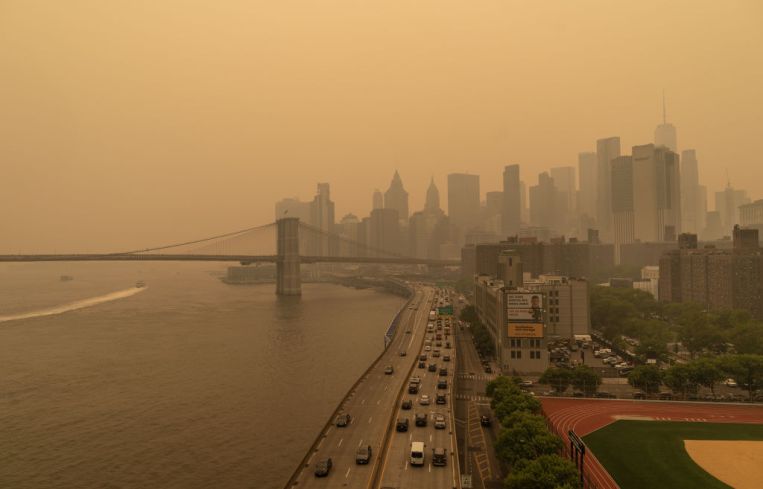New York’s Wildfires Haze a Harsh Reminder for Office Owners
They prepared so much for improvements to indoor air quality. What about when the bad stuff wafts in from outside?
By Rebecca Baird-Remba June 9, 2023 4:38 pm
reprints
As Canadian wildfire smoke swept across New York City and much of the Northeast this week, leaving behind the worst air pollution that the country has seen in decades, many New Yorkers realized the ventilation systems in their newly renovated office buildings weren’t up to the task of filtering smoke-filled air.
Even buildings running new heating and cooling systems with the most effective commercial filters on the market couldn’t eliminate the smell, which was like woodsmoke with an acrid tang of pollutants blown hundreds of miles from forest fires.
One such building was 120 Broadway in the Financial District, a beautiful Beaux Arts office tower from the 1910s where owner Silverstein Properties had undertaken a soup-to-nuts renovation of the mechanical systems, lobby and several office floors just before the pandemic. Like all of its buildings, Silverstein had installed MERV-15 filters at the property, which can filter out up to 95 percent of particles in the air, including severe pollutants.
When used for preventing the spread of airborne viruses — including the coronavirus that causes COVID-19 — these filters tend to work pretty well. And indeed, by Silverstein’s metrics, the indoor air quality in the building was within the normal range, even during the worst of the wildfire smoke on Wednesday. Still, like everywhere else in the city, tenants inside could smell smoke, blown in through open doors, open windows, and stuck to people’s clothing. It was a challenge that office owners all over New York confronted.
On that Wednesday, June 7, the Air Quality Index — which measures the level of hazardous pollution particles in the air — hit 480 out of a potential 500 in New York City, which was the worst air quality the city had seen since it started measuring in 1999. That level of pollution was also worse than the last recorded high from San Francisco in November 2018, when Northern California experienced a wildfire season of unprecedented severity. The smoke was a unique event on the East Coast — one that most commercial landlords never planned for.
Guy Vardi, Silverstein’s chief innovation officer, explained that the company “went with a radical transparency approach where we installed air quality sensors in all of our buildings.” Tenants have access to a proprietary app, Inspire, where they can see the levels of carbon dioxide and other air quality metrics in their building. He noted that Silverstein was exploring an artificial intelligence technology that predicts the best times to open the fresh-air intakes for the building, so that the vents can be open during the few minutes per hour that the outside air is cleanest.
“Our assumption is that the weather is not going to become nicer,” said Vardi. “We are enjoying a relative calm period, but it is not going to be like this moving forward. One level of defense is to decide when we are going to open the intake.” He added that thanks to the sensor system, “we are going to alert you if the air quality is going to drop below a certain threshold.”
Vardi noted that filters can strip out most of the airborne pollutants, but the wildfire smell is much harder to eliminate. High-efficiency particulate air (HEPA) filters are the most effective option on the market, but they are too thick to be used on commercial HVAC systems, which need to maintain a specific level of air pressure to function properly.
Alexej Goehring, an associate principal at Arup in the engineering firm’s San Francisco office, pointed out that wildfire smoke was nothing new for the San Francisco Bay Area, which had severe wildfire seasons in 2017, 2018 and 2020.
“A lot of the recommendations for COVID or pathogens was to increase the amount of outside air, which is not what you want when you have an outdoor pollution problem,” he explained. “What you want to be doing if you have an external pollution problem is to minimize the amount of outside air coming into the building and recirculate as much as possible. That’s applicable for wildfires, smog and outside pollution.”
Goehring said one option that works well for commercial heating and cooling systems is activated charcoal filters, which can be installed to help mitigate smells from fires.
Residential homes and apartment buildings often are not set up to filter the air as effectively, but they can be set to recirculate the indoor air during wildfires. Stand-alone air purifiers with HEPA filters are often the best option for people at home, he said.
In a pinch, there are do-it-yourself alternatives like Corsi-Rosenthal boxes, which can be constructed out of MERV-13 filters and a box fan.
Daniel Myers, founder and CEO at smart home technology company Flair, noted that his “smart vents” make it easier to push cleaner air to rooms in a home that people are actually using. So, during the day, users could close the vents in rooms they don’t use — like the bedroom — and push clean air to rooms they occupy, like home offices or living rooms. The vents can replace normal air vents in a home or apartment with central air, and can be opened or closed remotely.
“You can schedule what rooms you work with at what times,” Myers explained. “We make sure you have the most filtered air entering those rooms at any given time.”
Rebecca Baird-Remba can be reached at rbairdremba@commercialobserver.com


